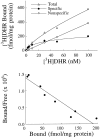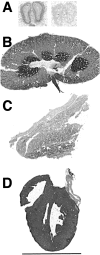[3H]dihydrorotenone binding to NADH: ubiquinone reductase (complex I) of the electron transport chain: an autoradiographic study
- PMID: 8656275
- PMCID: PMC6578603
- DOI: 10.1523/JNEUROSCI.16-12-03807.1996
[3H]dihydrorotenone binding to NADH: ubiquinone reductase (complex I) of the electron transport chain: an autoradiographic study
Abstract
Abnormalities of mitochondrial energy metabolism may play a role in normal aging and certain neurodegenerative disorders. In this regard, complex I of the electron transport chain has received substantial attention, especially in Parkinson's disease. The conventional method for studying complex I has been quantitation of enzyme activity in homogenized tissue samples. To enhance the anatomic precision with which complex I can be examined, we developed an autoradiographic assay for the rotenone site of this enzyme. [3H]dihydrorotenone ([3H]DHR) binding is saturable (KD = 15-55 nM) and specific, and Hill slopes of 1 suggest a single population of binding sites. Nicotinamide adenine dinucleotide (NADH) enhances binding 4- to 80-fold in different brain regions (EC50 = 20-40 microM) by increasing the density of recognition sites (Bmax). Nicotinamide adenine dinucleotide phosphate also increases binding, but NAD+ does not. In skeletal muscle, heart, and kidney, binding was less affected by NADH. [3H]DHR binding is inhibited by rotenone (IC50 = 8-20 nM), meperidine (IC50 = 34-57 microM), amobarbitol (IC50 = 375-425 microM), and MPP+ (IC50 = 4-5 mM), consistent with the potencies of these compounds in inhibiting complex I activity. Binding is heterogeneously distributed in brain with the density in gray matter structures varying more than 10-fold. Lesion studies suggest that a substantial portion of binding is associated with nerve terminals. [3H]DHR autoradiography is the first quantitative method to examine complex I with a high degree of anatomic precision. This technique may help to clarify the potential role of complex I dysfunction in normal aging and disease.
Figures











References
-
- Andreani A, Rambaldi M, Locatelli A, Leoni A, Ghelli A, Degli Espositi M. Thienylvinylindoles as inhibitors of mitochondrial NADH dehydrogenase. Pharm Acta Helv. 1994;69:15–20. - PubMed
-
- Belogrudov G, Hatefi Y. Catalytic sector of complex I (NADH:ubiquinone oxidoreductase): subunit stoichiometry and substrate induced conformation changes. Biochemistry. 1994;33:4571–4576. - PubMed
-
- Benecke R, Strumper P, Weiss H. Electron transfer complex I defect in idiopathic dystonia. Ann Neurol. 1992;32:683–686. - PubMed
-
- Bindoff LA, Birch-Martin M, Cartlidge NEF, Parker WD, Turnbull DM. Mitochondrial function in Parkinson’s disease. Lancet. 1989;1:49. - PubMed
-
- Blandini F, Greenamyre JT. Effects of subthalamic nucleus lesions on mitochondrial enzyme activity in the rat basal ganglia. Brain Res. 1995;669:59–66. - PubMed
Publication types
MeSH terms
Substances
Grants and funding
LinkOut - more resources
Full Text Sources
Other Literature Sources
